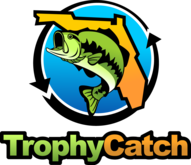 TrophyCatch Season 5 has already been one for the record books! The conservation program has now approved over 6,000 submissions since its start in October 2012, with catches documented from over 230 public waterbodies in Florida. Through March, Season 5 has contributed over 950 approved trophy bass to the program, as well as moved Lake Kissimmee to the undisputed top TrophyCatch bass lake. Lake Kissimmee has over 600 approved catches, which accounts for 10% of the total number of fish in our program! That is a lot of trophy bass documented for research, and released to be caught again in Florida, the “Bass Fishing Capital of the World”!
|
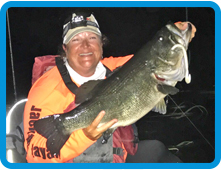 We could be looking at another banner season for Hall of Fame (HOF) catches 13 pounds or larger! As of the end of March we have approved 11 HOF submissions—and counting! This compares very favorably with previous years, and we will all be watching to see if we beat the record of 17 HOF catches set in Season 3. Our current HOF leader is Jean Ann Wilson with her 15 lbs catch on the Wacissa River on Feb. 7, 2017—the first 15-pound bass since Season 3! (She is pictured here with her 12 lbs 12 oz fish caught on the Wacissa on March 25.) Thanks go to all of our participants for making Season 5 another great year, and to our valued partners Bass Pro Shops, Mercury Marine, Phoenix Boats and others for making the catch-and-release of trophy bass even more exciting and rewarding!
|
What creates a trophy bass? Where are Florida's largest bass found? And why do some waters produce bigger trophies than others? These are great questions, and if you've participated in TrophyCatch you are helping to answer them! Data collected from TrophyCatch has already been presented at national fisheries conferences, and is fueling studies to better understand and manage Florida's most popular freshwater sportfish. To find out more about the research your TrophyCatches are contributing to, check out the brand new TrophyCatch Research Website! |
|
 |
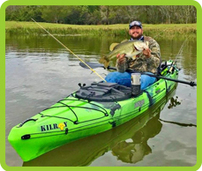 |
|
'Yaking it up! We have received an increasing number of kayak-caught TrophyCatches this season! While hooking and landing a trophy bass is a challenge in and of itself, doing so from a kayak really raises the bar! Here is Dennis
Schaefers and his 9 lbs 10 oz
Lunker Club fish caught-and-released in a Polk County pond in January. Also note that the current season leader is Jean Wilson with a kayak-caught 15 lbs bass from the Wacissa River!
|

Size: The state record is 6.96 pounds, although most fish will average between 1-2 pounds. The Big Catch minimum qualifying sizes are 3.00 pounds or 22 inches for adults, and 2.25 lbs or 17 inches for youth (BigCatchFlorida.com).
Identification and similar species:
The toothy mouth and elongated shape of this fish are diagnostic, as is
the unique, chainlike patterning along the body from which this
species draws its name. The redfin pickerel (as the name
states) has red fins, is smaller (seldom exceeding a pound), and lacks the
chainlike markings. A pickerel’s wider snout easily
distinguishes it from a gar’s narrow mouth.
Angling qualities: More sought-after in northern states, chain pickerel are
generally caught unintentionally in Florida—usually by bass anglers. This is due
to the pickerel’s love of minnows and minnow-imitating lures. Saltwater
anglers will note a body design that mimics a barracuda’s, and this fish is
indeed built for speed. Strikes are usually very fast and aggressive. Once
hooked, the chain pickerel is known for its fast runs and jumping ability. Some
bass anglers lament the damage a pickerel’s teeth can do to a lure or bait, but
others welcome strikes from this torpedo-shaped aerialist, and consider a
scuffed lure a small price to pay for the adventure. Due to this toothy mouth,
care should be taken when landing. While
pickerel are certainly edible, many small bones make it difficult
to separate the meat and most enthusiasts consider the pickerel
to be much more a sport fish than a table fish.
Where to catch them: Chain pickerel are uncommon to common throughout Florida's lakes and rivers, and can also be found in south Florida's extensive canals. They are seldom far from vegetation, and prefer quieter pools of streams or rivers.
Illustration by Duane Raver, Jr.
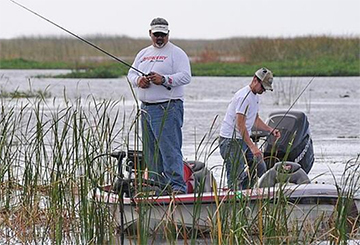 Size: 30,800 acres.
Location: Orange and Lake Counties.
Description: Lake Apopka is the largest lake on the Harris Chain-of-Lakes, and one
of the largest lakes in Central Florida. Throughout the 1940s, Lake Apopka was
one of Florida’s premier fishing attractions. With a reputation for being one of North
America’s most productive trophy bass lakes, anglers traveled
across the country by train to stay at one of the many fish camps that dotted
the shoreline.
Unfortunately the draining of wetlands to create muck during the turn
of the century led to an influx of pesticides, herbicides and fertilizers,
leaving Lake Apopka heavily degraded by the end of the century. But today the lake is making a comeback. Significant strides have been made to return the lake to a healthy water body through the cooperative efforts of numerous state
agencies, universities, municipalities and local residents. Water quality is
improving along with a resurgence in the sport fishery. In recent years
habitat restoration efforts have included planting native aquatic vegetation,
installing fish attractors, and stocking over a million
sportfish including largemouth bass and hybrid striped bass (sunshine bass). Anglers can find good densities of quality bass, crappie, sunfish (bream) and hybrid stripers. Most of the
good fishing occurs on the southern and western shorelines. Anglers should target the area
around Gourdneck Springs, located in the
southwest corner of the Lake. Fish along the grass lines and focus on areas
where logs and tree limbs provide cover.
Although Lake Apopka is one of Florida’s largest lakes, it receives relatively little
fishing pressure due to a quieter reputation in recent years despite many fish to be caught. However, many savvy anglers fishing
amateur and professional tournaments on the Harris Chain quietly make their way
down the Apopka-Beauclair Canal to fish Lake Apopka, improving their odds of
returning to the weigh-in with a trophy catch.
There are three public boat ramps located on Lake Apopka. For more information
on how to access Lake Apopka and the rest of the Harris Chain of Lakes, please
visit our Florida Boat Ramp Finder.
|
 If you fish for panfish and haven’t tried grass shrimp yet, then you need to know: You’re missing out! Freshwater grass shrimp are an excellent bait for all species of sunfish, come free and are usually easy to collect.
There are a variety of species of grass shrimp, and as the name implies grass shrimp are usually associated with vegetation. They reach about two inches in size. But all you need to know as an angler is that grass shrimp catch fish! Although used primarily as a panfish bait, few freshwater fish will turn their nose up at a grass shrimp including bass up to several pounds.
|
|
So how do you get this great bait? In most lakes, it’s fairly easy.
You’ll need a sturdy-framed, long-handled dip net with a mesh size of
1/4” or so. A larger mesh will let shrimp escape, while a finer mesh
will become clogged with vegetation and silt and not drain well. Any
kind of reinforcement of the net bag around the frame is a major plus,
because this net will really be “beating the bushes." Bait and tackle
shops sell a variety of nets that will work, but if you have trouble
finding an ideal net, this certainly won’t prevent you from catching
shrimp. As long as the mesh size is about right, almost any dip net
should work at least moderately well.
Next, you’ll need a lake or
canal with some vegetation in it. Emergent shoreline grass is ideal, but
any shoreline vegetation that you can readily run your net through
should produce results. "Beat” the net through the vegetation in several
consecutive sweeps through the same spot, pushing the vegetation down
as you sweep (the vegetation usually pops back up unharmed). Then plop
the net on the ground and pick through the vegetation accumulated in the
bottom of the net bag for your tiny quarry.
|
|
 |
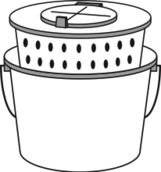 The shrimp go into a standard
small bait bucket or “minnow bucket” with latching lid, available at
most bait and tackle shops. Two versions of these plastic buckets are
available, one just the standard bucket and the other a ventilated
bucket that rests inside a larger bucket. The ventilated bucket design
makes water changes easy—just pull it out of the main bucket, let the
water drain, and then submerge it in the lake to refill it before
placing it back in the main bucket. You can also leave such a bucket in
the water, but some of the grass shrimp you catch will be small enough
to work their way out of the holes—ditto for draining the bucket if the
day’s catch of shrimp is running small. Grass shrimp are a hardy bait,
and only an occasional water change is needed to keep them healthy as
long as they are kept cool and out of the sun.
|
Because
of both the small size of a sunfish’s mouth and the diminutive size of
the grass shrimp, use a #8 or #10 Aberdeen hook when fishing shrimp for
sunfish. Hook the bait through the bend in the tail. Keep your bobber
equally small; it takes almost no flotation at all to suspend a grass
shrimp. One-inch, cylindrical foam bobbers work well. These also put up
little resistance when a wary sunfish takes the bait; it will be more
likely to hang onto the shrimp rather than dropping it. Position the
bobber about three feet above the hook for starters, but adjust for a
deeper presentation if you don’t get any bites pretty quickly. Use a
tiny split shot to sink the shrimp to the desired depth.
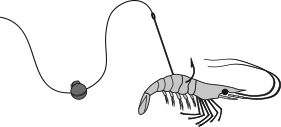 |
Of
course, grass shrimp can also be fished on the bottom—where the bigger
bluegill and redear sunfish often congregate. (A general rule when going
after bream is to fish deeper if all you are catching are small ones.)
Use only enough weight to cast your bait where you want to place it, and
keep it there—that’s usually just a couple of split shot or at most a
1/8 ounce egg sinker set a foot or so ahead of the bait. Set the hook as
soon as you feel a bite—fish will swallow grass shrimp without
hesitation, so there’s no need to delay when the strike comes.
So
there you have it. Grass shrimp may not always work better than live
worms or crickets, but they do nearly always work at least as well. And
they’re as fun to catch as they are to fish—give them a try!
"He swims like a fish!" It's an expression you might have heard during last year's Summer Olympics. But how, exactly, do fish swim? Water is a much denser substance than air, and therefore
much more difficult to move through. Fish have to be hydrodynamically
streamlined (think aerodynamically, only underwater) in order to travel
efficiently. For some species speed is most important, while for others
maneuverability and turning ability are critical. In fact, you can tell a lot
about how a fish moves—and how it makes a living—simply by the shape of its
body.
First,
how do fish swim at all? Basically, they undulate their bodies through the
water in a snakelike motion. The undulations pass through the fish’s muscles in
waves, and end with a brisk tail snap.
Fish swim by undulating through the water.
Forward motion is provided by both the pushing of the fish’s
body against the water, and by the final tail snap. The water is actually
pushed backward and—in accordance with Newton’s Third Law that for every action
there is an equal and opposite reaction—the fish itself is thrust forward as
this water is pushed off the fish’s body and tail. The rate at which
these undulations pass through a fish’s muscles have a direct relationship to a fish’s speed. In some ways, this thrust is similar to that produced by the
propeller on a boat motor.
A long,
skinny fish such as a pickerel derives most of its forward motion from the
muscle wave. Part of this is due to the fact that such a long fish can generate
more waves in its body than a stubbier and thicker fish. Also note that a
pickerel’s fins have a relatively small surface area compared with the length
of the body, and the small caudal (tail) fin provides a correspondingly smaller
amount of forward motion during the tail snap. On the other hand, a stockier
species like the largemouth bass gets most of its speed from the tail snap of
its large caudal fin, but not as much forward thrust from the muscle wave of
its stubbier body. As the illustration shows, a bass can’t generate as many
waves in its shorter and stiffer body as a long supple pickerel can. For nearly
all fish, though, both are important in providing thrust.
A long, supple pickerel (top) can produce more muscle waves along its body than a short, stocky bass (bottom).
What
can we learn about how a fish lives by how it swims? Once
again, let’s compare the pickerel and the bass. The pickerel’s long streamlined
body is designed for speed. Its small fins tend to be farther
back on its body, increasing its hydrodynamic efficiency and allowing it to
“knife” through the water more easily. The pickerel can therefore be assumed to
be a high speed feeder, able to run down and capture its prey. You can also
assume that if this is true, then the pickerel must feed on fast-moving prey
organisms such as fish as opposed to slower foods such as crayfish. And this is
exactly the case.
The
largemouth bass, on the other hand, is stockier in build and probably only able
to achieve high speeds briefly and over short distances. Thus, a largemouth is
an ambush feeder, surprising and capturing its prey from relatively
short range. The comparatively larger size of its fins, as well as their
placement closer to the center of the body, also indicate that for a bass
maneuverability is more important than velocity. Rather than running down prey over distance,
the bass should be able to turn and maneuver sharply enough to capture its food
almost immediately once it gets close to it. In addition, rather than
concentrating its diet strictly on fast-moving prey, the bass is more likely to
be a generalist predator, eating a broader range of prey species than the
pickerel (able to capture fish when the opportunity arises, but also consuming such
prey as crayfish and frogs). Again, this proves to be the case.
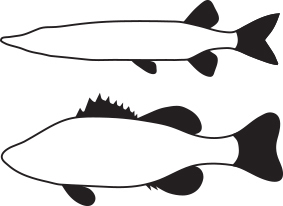 |
Note the differences in body shape and size and position of the fins between a pickerel and a bass.
How fast can fish swim? As one can
imagine, clocking fish underwater is not easy! However, bass have been measured
traveling at about 12 miles per hour (mph), and salmon slightly faster at 14. The
real speed records, however, all go to saltwater fish. The barracuda—very
similar in shape and feeding strategy to the pickerel—can move at about 28 mph.
By far the fastest fish are the open ocean species. Bonitos and marlin have
been estimated to reach 40 mph, while speeds of up to 60 mph(!) have been
attributed to swordfish and tunas.
To contact the Florida Freshwater Angler, email John Cimbaro.
|